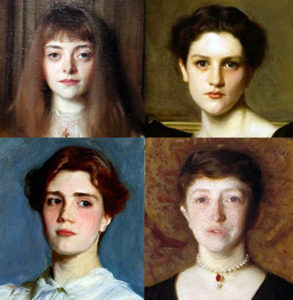Author discusses John Singer Sargent
By Page H. Gifford, Correspondent
It took author Donna M. Lucey eight years write her book about master portrait painter John Singer Sargent and the high-society women of the gilded age he immortalized on canvas. Lucey discussed her latest book, Sargent’s Women: Four Lives Behind the Canvas, with the Friends of the Library at their Sept. 5 meeting.
Lucey is an award-winning author and scholar. She is the recipient of two NEH grants and is a 2017 writer-in-residence at Edith Wharton’s home, The Mount. She chose four women out of the 900 women Sargent painted, because they were American and because of their geographical locations.
“I visited the places where these women lived, rummaged through attics, read letters and diaries and discovered many twists and turns in their stories,” said Lucey. She conveyed the excitement she experienced as she read their innermost thoughts and compared them with what Sargent saw as he painted.
She began by reading the exquisitely written introduction to the book. Lucey brings her readers back into a time when women lived in the shadows of their fathers and husbands and their social standing was defined by wealth. She showed Sargent’s defining moments when he is commissioned to paint these women, spending time with them and befriending them.
 Sargent captured the passions, desires and character of these women who defied the norms of their times, testing the limits of impropriety and engaging in the unexpected. After a while, Sargent himself grew to despise portraiture. Some may wonder if he had any relations with these women but Lucey stated it was rumored he was homosexual.
Sargent captured the passions, desires and character of these women who defied the norms of their times, testing the limits of impropriety and engaging in the unexpected. After a while, Sargent himself grew to despise portraiture. Some may wonder if he had any relations with these women but Lucey stated it was rumored he was homosexual.
Elsie Palmer
“Elsie Palmer was 17 when Sargent painted her and it took him over a year to complete it,” she said. She had changed a lot in that year from when Sargent began until he finished it. Elsie’s father and grandfather’s wealth came from the railroads and mining and her grandfather founded Colorado Springs. “Elsie Palmer had lived in New York City at the Dakota but mostly traveled between her father’s Rocky Mountain castle and the 14th century English manor house where her mother took refuge, surrounded by artists, writers, and actors.” This was a common thread among these women who were surrounded by writers and artists like Sargent; they were influenced by ideals larger than what they knew and yearned for something outside their current lives.
“Elsie falls in love with her mother’s friend, Peter Harrison, who is also falling in love with her and takes her back to New York and becomes her guardian,” said Lucey. “Not a good thing – but then he falls in love with her younger sister and dumps Elsie.” She then ended up taking care of her father when he became a quadriplegic as a result of a riding accident. “She later married Leo Howard, a spiritualist from England. It was an epistolary romance.” She added that it was the fad then to engage in seances and spiritualism. “When she married him she wore a wrap adorned with bronze buckles and little animals. Elsie was considered strange and led a strange life.”
Sally and Lucia Fairchild
Sargent’s painting of Sally Fairchild at 21 was one of a few he painted of her, but this one was outdoors, and she had a veil over her face. Sally was considered the more beautiful of the two sisters; her younger sister, Lucia, was known as the ugly duckling. Yet, as they matured, Lucia was just as beautiful. Lucia adored the workaholic Sargent, who became her friend and mentor when she took up art. Later, she attended the Cowles Art School and the Art Students League of New York, and became an accomplished American artist in her own right.
“When she became interested in Henry Fuller, she asked Sargent if she should marry for love and Sargent replied, ‘Absolutely not,’” Lucey said. She married Harry and both of them abandoned the conventions of their wealthy lives and went to live a Bohemian life in an artist’s colony in Cornish, N.H. Lucey described the colony as one of those places where being free of societal norms, progressive thought and being risqué was acceptable. “Harry’s models were all naked,” she said. She showed one of his paintings featuring his wife and daughter Clair, both naked.
By 1889, Lucia began painting professionally and produced mainly miniatures. She was awarded numerous medals for her work at expositions and founded the American Society of Miniature Painters. She was also a member of the New York Watercolor Club.
“She painted miniatures for many wealthy families, but they never paid her a decent price for her work.” Lucia didn’t limit herself to small scale work and exhibited at the Palace of Fine Arts and her mural Women of Plymouth in The Woman’s Building at the 1893 World’s Columbian Exposition in Chicago.
Eventually, she hit hard times; Fuller proved to be a womanizer and she found herself stranded in New York with her two daughters. She wasn’t feeling well herself and eventually lost her sight to multiple sclerosis.
She died in 1924 of MS and Harry ended up in a trailer park.
Elizabeth Astor Winthrop Chanler
“Elizabeth Astor Winthrop Chanler limped into his studio at the age of 27,” Lucey said.
She grew up in Rokeby, in the Hudson Valley of New York, while her father lived in New York City. She lived in a chaotic household with 10 children as the third oldest, and was raised by a cousin and servants.
As was the trend back in those days, wealthy families married their daughters to English noblemen for their titles, and in turn the English noblemen gained vast wealth through marriage to keep the estates going. At the same time, many sons of wealthy Americans were schooled in England as were two older brothers whom the 11-year-old accompanied to England.
“She was then enrolled in Bonchurch, a school on the Isle of Wight, off the southern coast of England,” said Lucey. “The school was run by three old maid sisters who frowned upon wearing anything scarlet or reading Dickens.” The school housed eight girls aged 14 to 18, all English, and this left Elizabeth feeling out of place and homesick. After her father died, the family left her at the school, making her one of the Astor orphans.
To make things worse, because of her physical problems and difficulty walking, she was sent to the Royal Orthopedic Hospital in London for treatment, which included the use of a backboard. She returned to the school and wanted to return to Rokeby but everyone felt the house was too chaotic for someone so fragile.
“At 21 she inherited money from her father and then she became close friends with John Jay Chapman (related to Justice John Jay), and his wife, and she fell in love with him,” she said. “He was an intense man, and while he was at Harvard studying law, he took a cane and almost struck a fellow student. When he went home, he was so horrified at what he almost had done he put his arm in the fire and burned most of it off.” Gasps rose from the audience trying to imagine why anyone would do this.
“His wife died in childbirth but both realized at the time that because of the time it took to mourn, a year or so, it was frowned upon to be seen together after the death of a spouse so they met in secret and finally married when the Spanish-American War broke out because it was an uncertain time and marriages were permitted,” Lucey said.
The next installment of Elizabeth’s life took one of those unexpected turns when her husband had a complete mental breakdown, lying in a fetal position in the attic, and she ended up caring for her son and her two step children.
Isabella Stewart Gardner
The New Yorker, iron-willed Isabella Stewart Gardner, shocked Boston society and at first Sargent loathed her. Later, however, she became Sargent’s greatest patron and friend.
“She’s not a woman but a locomotive,” said Sargent. She broke through the stuffy, provincial norms of Boston society with her scandalous portrait and stylish New York fashions, not to mention dancing with men who were not her husband. She was not as attractive as the other three women Lucey spoke about, but she made up for it with her flamboyancy.
After she married, she lost her first child before two years of age and miscarried the next and was told she would never have any more. She took to her bed and became sickly, but then the old Isabella emerged when she began to travel. She also studied classical education.
“Traveling was normal for the wealthy in those days and sometimes you would be gone for over a year,” Lucey said. While in Egypt, Gardner would play in the sand, “feeling ancient Egypt.” Both she and her husband, John Lowell Gardner II, became patrons of the arts. While he funded her trips, she collected art from all over Europe, beginning with a Vermeer. In later years she created and built a museum out of her sprawling home in Boston. And the Isabella Stewart Gardner Museum remains a tribute to her effort to preserve great works of art.
“In her will she stated that nothing was to be moved in the museum except for cleaning or restoration. If it was then everything would be sold in Paris and donated to Harvard.” She added that every year an official from Harvard checks to see that everything is in place and there is no violation.
Like many famous women of the gilded age, she left a legacy in the arts and culture that would educate future generations. Breaking through the barriers that suppressed women of her time midst the gossip and scandal of a provincial Boston society, she brought European culture to the Back Bay. It is only fitting that Lucey’s story of these three women all circle back to the man who first painted them, John Singer Sargent. His last portrait of Gardner was after she suffered a stroke and, trying to hide the fact, he draped her all in white and painted her for the last time. Today, his work hangs in her museum.



